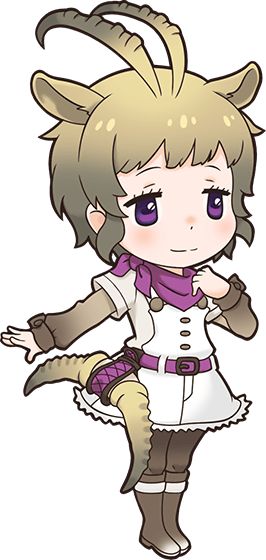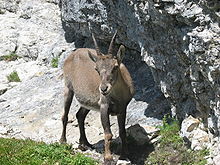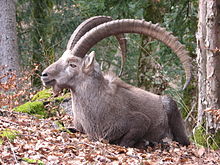Alpine Ibex: Difference between revisions
mNo edit summary |
No edit summary |
||
| (8 intermediate revisions by 5 users not shown) | |||
| Line 1: | Line 1: | ||
{{FriendBox | {{FriendBox | ||
|name=Alpine Ibex | |name=Alpine Ibex | ||
|originalpic=Alpine IbexOriginal. | |originalpic=Alpine IbexOriginal.png | ||
|aka=Ibex | |aka=Ibex | ||
|name_jp=アイベックス | |name_jp=アイベックス | ||
| Line 14: | Line 14: | ||
}} | }} | ||
{{FriendBuilder | {{FriendBuilder | ||
|introduction=The '''Alpine Ibex''' is a | |introduction={{quote|... I like doing nothing. But, if I see a climbable wall, I'll unconsciously climb it. Ah, if I find climbable cliff. If it's about this height, you do it like this, quickly climb it... ... Alright, I arrived at the summit, I worked up a nice sweat!|Alpine Ibex's introduction}} The '''Alpine Ibex''' is a bovid [[Friend]] that appeared in the original Kemono Friends mobile game. | ||
|appearance=Alpine Ibex has short brownish grey hair which is cut very close to the head, with the hair left long enough to | |appearance=Alpine Ibex has short brownish grey hair which is cut very close to the head, with the hair left long enough to pass the fringe. She has small, feather-like hairs on the topmost head spot, representing the female alpine ibex's horns. She has purple eyes, and the ears and tail of an alpine ibex. | ||
Alpine Ibex wears a white sleeveless coat dress which has five buttons, three of them vertically aligned on the belly and two of them on her chest. Her coat has a purple belt which slightly extended to her right to hold horns which have the shape of a boomerang. The coat's edges have white fur. | Alpine Ibex wears a white sleeveless coat dress which has five buttons, three of them vertically aligned on the belly and two of them on her chest. Her coat has a purple belt which slightly extended to her right to hold horns which have the shape of a boomerang. The coat's edges have white fur. Inside her coat, she wears a brownish grey blouse with sleeves extending to her arms with each cuff closed with one button. She wears black tights, and boots which have a white line around the upper part. Around her neck, she bears a purple bandana. | ||
Alpine Ibex carries a boomerang, shaped like a pair of ibex horns connected base-to-base, in a holster on her right hip. | |||
|t0=No | |||
|t1=Yes | |||
|nxnrole=Minor character, obtainable | |||
|t2=No | |||
|t3=No | |||
|t4=No | |||
|t5=No | |||
|t6=No | |||
|t7=No | |||
|t8=No | |||
|t9=No | |||
|t10=No | |||
|t11=No | |||
|t12=No | |||
|t13=No | |||
|t14=No | |||
|t15=No | |||
|t16=No | |||
|t17=No | |||
|t18=No | |||
|t19=No | |||
|t20=No | |||
|t21=No | |||
|t22=No | |||
|t23=No | |||
|t24=No | |||
|t25=No | |||
|t26=No | |||
|t27=No | |||
|t28=No | |||
|reallife=[[File:Alpine_Ibex_Female.jpg|thumb|upright=1.0|left| Female Alpine Ibex(Capra ibex)]] | |reallife=[[File:Alpine_Ibex_Female.jpg|thumb|upright=1.0|left| Female Alpine Ibex(Capra ibex)]] | ||
The | The alpine ibex ''(Capra ibex)'', also known as the ''steinbock'' or ''bouquetin'', is a species of [[Wikipedia:Wild goat|wild goat]] that lives in the mountains of the European Alps. They typically inhabit open, rocky habitats at high altitude, above the tree line. Steep, south-facing slopes with rugged topography and grassy vegetation are preferred. Below the tree line, at sub-alpine levels, ibexes are only found in open, sunny woodland interspersed with rocky outcrops. | ||
Both male and female alpine ibex have long, backwards-curving horns with numerous ridges along their length, those of the males are substantially larger than those of females, which are slightly shorter, thinner, and curve slightly more. The ibex's horns are used to defend themselves against predators and, for males in particular, to rut when competing for mating rights. Like many goats and goat relatives, male alpine ibexes have long beards. | |||
Ibexes are herbivores, dining on shrubs, bushes and grasses; grazing in particular accounts for a significant part of the alpine ibex's eating habits. The low nutritional value of their diet means the ibex must spend much of the day eating, becoming active in the afternoon and feeding throughout the night in the forest, returning to the safety of rock cliffs come morning. In the spring the animals migrate into the mountains to access new feeding areas; in winter, when the snow is deep and the weather is severe, they migrate down to south-facing slopes which have more food and less snow. | |||
Alpine ibexes are well-adapted to life on sheer cliff face habitats. Incredibly nimble, the alpine ibex can jump more than six feet (1.8 meters) straight up without a running start, and their cloven hooves grant then greatly increased traction and manoeuvrability on rough terrain. Being able to scale these heights is an ibex's greatest defensive technique, as very few predators can follow them to the steepest precipices of their habitats. Among the few predators of the species are snow leopards and eagles, which are capable of climbing steep cliffs and simply flying over them, respectively, while bears and humans prey on alpine ibex when they venture into lower regions. | |||
* In the eighteenth century some Europeans believed ibex were magical. Today's equivalent of the magical ibex is the zodiac sign Capricorn. | Although the species is not considered threatened, there are concerns regarding genetic diversity and a waning number of viable populations. The alpine ibex is protected under national legislation in most range states, and has been the subject of intensive conservation management in the form of wild reintroduction. | ||
|trivia=[[File:Alpine_Ibex_Male.jpg|thumb|upright=1.0|right| Male alpine ibex (Capra ibex).]] | |||
===Animal Trivia=== | |||
* There are five species of ibex, according to the Integrated Taxonomic Information System (ITIS). | |||
* As a browser, this ibex probably regulates local vegetation growth. As a prey species, it is likely that the availability of ibex impacts the populations of predators. In this way, the alpine ibex is likely a keystone species within its environment. | |||
* In the eighteenth century, some Europeans believed ibex were magical. Today's equivalent of the magical ibex is the zodiac sign Capricorn. | |||
**The alpine ibex, [[Nubian Ibex|Nubian ibex]] and [[Himalayan Tahr|Himalayan tahr]] are closely related species; all hail from the bovid family's ''Caprinae'' subfamily, and fall within the ''Caprini'' tribe thereof. Alpine and Nubian Ibex belong to the ''Capra'' genus, while Himalayan Tahr comes from ''Hemitragus''; these genii directly diverged from one another and are not known to have diverged since. | |||
|reference=1. "[http://www.iucnredlist.org/details/42397/0 Capra ibex]". IUCN Red List of Threatened Species. | |reference=1. "[http://www.iucnredlist.org/details/42397/0 Capra ibex]". IUCN Red List of Threatened Species. | ||
Latest revision as of 02:46, 19 June 2024
Alpine Ibex
| |||
|---|---|---|---|
| アイベックス | |||
| Character Data | |||
| AKA | Ibex
| ||
| Romaji | Aibekkusu
| ||
| Debut | Kemono Friends (2015 Game) | ||
| Animal Data | |||
| Scientific Name | Capra ibex
| ||
| Distribution | Alps
| ||
| Diet | Herbivore
| ||
| Avg. Lifespan | 10-18 years
| ||
| Read More | Alpine ibex
| ||
| Conservation | 
| ||
| Alpine Ibex | Nexon Game |
“... I like doing nothing. But, if I see a climbable wall, I'll unconsciously climb it. Ah, if I find climbable cliff. If it's about this height, you do it like this, quickly climb it... ... Alright, I arrived at the summit, I worked up a nice sweat!”
—Alpine Ibex's introduction
The Alpine Ibex is a bovid Friend that appeared in the original Kemono Friends mobile game.
Appearance
Alpine Ibex has short brownish grey hair which is cut very close to the head, with the hair left long enough to pass the fringe. She has small, feather-like hairs on the topmost head spot, representing the female alpine ibex's horns. She has purple eyes, and the ears and tail of an alpine ibex.
Alpine Ibex wears a white sleeveless coat dress which has five buttons, three of them vertically aligned on the belly and two of them on her chest. Her coat has a purple belt which slightly extended to her right to hold horns which have the shape of a boomerang. The coat's edges have white fur. Inside her coat, she wears a brownish grey blouse with sleeves extending to her arms with each cuff closed with one button. She wears black tights, and boots which have a white line around the upper part. Around her neck, she bears a purple bandana.
Alpine Ibex carries a boomerang, shaped like a pair of ibex horns connected base-to-base, in a holster on her right hip.
Series Appearances
| Media | Role | |
|---|---|---|
| 2015 | Nexon Game | ↪ Minor character, obtainable |
In Real Life
The alpine ibex (Capra ibex), also known as the steinbock or bouquetin, is a species of wild goat that lives in the mountains of the European Alps. They typically inhabit open, rocky habitats at high altitude, above the tree line. Steep, south-facing slopes with rugged topography and grassy vegetation are preferred. Below the tree line, at sub-alpine levels, ibexes are only found in open, sunny woodland interspersed with rocky outcrops.
Both male and female alpine ibex have long, backwards-curving horns with numerous ridges along their length, those of the males are substantially larger than those of females, which are slightly shorter, thinner, and curve slightly more. The ibex's horns are used to defend themselves against predators and, for males in particular, to rut when competing for mating rights. Like many goats and goat relatives, male alpine ibexes have long beards.
Ibexes are herbivores, dining on shrubs, bushes and grasses; grazing in particular accounts for a significant part of the alpine ibex's eating habits. The low nutritional value of their diet means the ibex must spend much of the day eating, becoming active in the afternoon and feeding throughout the night in the forest, returning to the safety of rock cliffs come morning. In the spring the animals migrate into the mountains to access new feeding areas; in winter, when the snow is deep and the weather is severe, they migrate down to south-facing slopes which have more food and less snow.
Alpine ibexes are well-adapted to life on sheer cliff face habitats. Incredibly nimble, the alpine ibex can jump more than six feet (1.8 meters) straight up without a running start, and their cloven hooves grant then greatly increased traction and manoeuvrability on rough terrain. Being able to scale these heights is an ibex's greatest defensive technique, as very few predators can follow them to the steepest precipices of their habitats. Among the few predators of the species are snow leopards and eagles, which are capable of climbing steep cliffs and simply flying over them, respectively, while bears and humans prey on alpine ibex when they venture into lower regions.
Although the species is not considered threatened, there are concerns regarding genetic diversity and a waning number of viable populations. The alpine ibex is protected under national legislation in most range states, and has been the subject of intensive conservation management in the form of wild reintroduction.
Trivia
Animal Trivia
- There are five species of ibex, according to the Integrated Taxonomic Information System (ITIS).
- As a browser, this ibex probably regulates local vegetation growth. As a prey species, it is likely that the availability of ibex impacts the populations of predators. In this way, the alpine ibex is likely a keystone species within its environment.
- In the eighteenth century, some Europeans believed ibex were magical. Today's equivalent of the magical ibex is the zodiac sign Capricorn.
- The alpine ibex, Nubian ibex and Himalayan tahr are closely related species; all hail from the bovid family's Caprinae subfamily, and fall within the Caprini tribe thereof. Alpine and Nubian Ibex belong to the Capra genus, while Himalayan Tahr comes from Hemitragus; these genii directly diverged from one another and are not known to have diverged since.
References
1. "Capra ibex". IUCN Red List of Threatened Species.
2. "Facts About Ibex". Live Science.
3. "Capra ibex". Animal diversity Web.
4. "Alpine Ibex (Capra ibex)". Animal Corner.


